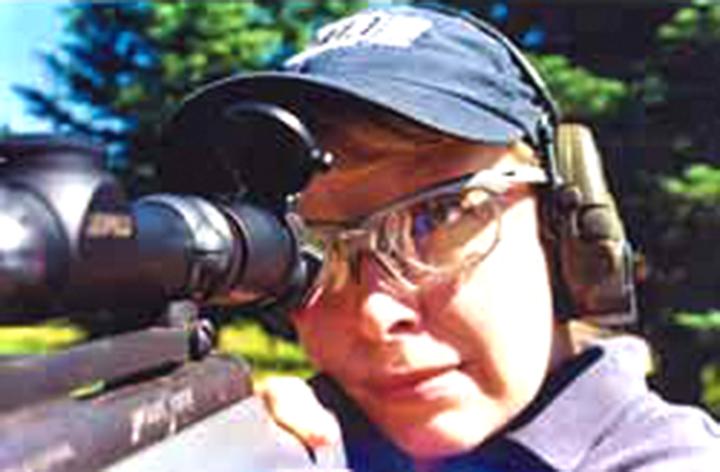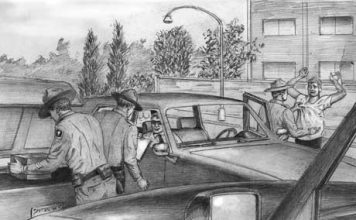 |
|
| Website Exclusive • January, 2004 |
Our three part series on firearms handling ends with this installment. In Part I, we covered handguns and in Part II, we followed with shotguns.
The rifle is a staple of the well-equipped farm, ranch, and backwoods home. Many ranchers handle them daily. For those who don’t fit that category and are a little rusty, we offer the following.
Training
|
Always remember that training is a good investment in anything serious. Your local fish and wildlife department, or your local gun shop, can probably steer you to certified instructors. So can the National Rifle Association, at their toll-free number 1-877-NRA-2000. Jeff Cooper’s Gunsite has an excellent course they call “General Rifle,” and Clint Smith’s Thunder Ranch still offers the course that made “Urban Rifle” a byword in training. Another good source is the Firearms Academy of Seattle where the pictures that accompany this article were taken. I particularly recommend the rifle classes FAS offers taught by Georges Rahbani. The graduates rave about the program.
Safety
You always want ear and eye protection when firing any kind of firearm, even a .22, for the shooters and any observers. When you’re shooting high-powered rifles, double ear protection – muffs and plugs – is recommended. The report of these guns is a high, hard crack that seems to hurt the ear more than the milder bang of most handguns or the deeper roar of the shotgun. With good ear plugs, you may get the illusion of the same sound attenuation you’re getting with muffs, but a lot of the sound vibration that causes the high range nerve deafness we call “shooter’s ear” is transmitted through the mastoid bone. Plugs do nothing to protect that area; muffs do a good job of it. However, stems of the mandatory shooting glasses may break the seal of the muffs at a critical point; hence, the logic of backup plugs. This is a good idea in any kind of shooting, but all the more so with high power rifles.
|
Always remember that there are damn few rifles with internal firing pin safeties. This means that a great many rifles can go off if dropped or struck hard enough on muzzle or butt. The mechanism of this type of accidental discharge is called “inertia firing” because the firing pin bounces in its channel from the momentum of the impact, striking the primer of the chambered cartridge with enough force to light it off.
Thus, unless you believe the need to shoot is imminent, it is best to keep the firing chamber empty even if the magazine is loaded. The same is true of a rifle (or shotgun, for that matter) kept loaded in a vehicle. (That practice is legal in public in some states, and usually legal on your own property in most other jurisdictions.) If the rifle is in a typical pickup truck window rack, or mounted horizontally across the front seat, there could be enough inertia if your vehicle is T-boned to fire the cartridge in the chamber. This is why the rifles and shotguns in police cars are always carried in what is called “Condition Three,” with loaded magazines but empty firing chambers. It is why most of the world’s military forces carry their assault rifles with empty chambers, which they only charge with a live round when in combat environments. It is why any experienced horseman or pack hunter will leave the chamber empty in any rifle carried in a saddle scabbard. Since a rifle kept loaded in the house for home defense could be dropped from its rack or resting place, it too should be stored with an empty chamber.
Ammunition
Make sure you use the right ammunition. One of the NRA’s “Ten Commandments of Firearms Safety” is to only carry one type of ammunition on your person so as not to get the
|
wrong cartridge into a firearm. This can’t always be done with defensive weapons. The last time I went on a raid I had .38/.357 ammo for my backup revolver, .45 ammo for my service pistol, and 9mm ammo for my issue MP5 submachinegun. However, when hunting with high-powered rifles, it really is a good idea to only have one type of rifle ammo on your person. I don’t think you’re going to get your revolver ammo mixed up with your .30/06 rifle ammo.
Let me give you an example. At my gun club not long ago, a member was sighting in his .270 and .308 hunting rifles when he suffered a serious accident. With ammo for both rifles on the shooting bench at the one hundred-yard line, he apparently just reached out for more cartridges by feel without checking the box, and loaded .308 Winchester cartridges into his .270 Winchester rifle.
You would not think a .30 caliber bullet would fit in a .27 caliber hole. However, the .270 is a “long action” cartridge, the length of a .30/06 round, and is in fact a “necked down” .30/06 in concept. The .308 Winchester cartridge, a.k.a. 7.62mm NATO, is essentially a shorter version of the .30/06 round, designed to allow “short actions.” Thus, the .308 cartridge was shorter enough in overall length that it fit in the long .270 chamber. Having the same case head diameter, the rifle’s mechanism picked it up and chambered it with no problem as the shooter thrust the bolt forward and locked it down.
But, when he pressed the trigger, all hell broke loose. The .31″ bullet DIDN’T fit the .27″ barrel, and what would normally be 50,000 or so pounds per square inch pressure contained in the ordnance steel firing chamber – business as usual when firing a high powered rifle – instantly skyrocketed and created catastrophic pressure. To put it simply, the gun blew up. Pieces of the strong, high-quality bolt action rifle flew everywhere, and particles of metal and burning gunpowder were driven back into the shooter’s face. He had committed the cardinal sin of lowering his shooting glasses to get a better view through his telescopic sight. The result was serious eye damage.
|
Once we know we have ammunition intended for the gun, we need to tailor the specific type of ammo to the task. Let’s say you have a rifle chambered for the .308 Winchester cartridge. Inexpensive full metal jacket ammo in the 150 grain bullet weight range is great to practice with, especially if you hunt deer with 150 grain soft nose ammo that hits to about the same point of aim/point of impact. However, it is against the law in most jurisdictions to shoot a deer with a full metal jacket bullet, because it tends to punch right through leaving a narrow wound track, often allowing the animal to escape only to die a lingering death later and rot in the woods.
Many years ago, my father in law decided to solve his woodchucks-in-the-garden problem with the only rifle he had, a Remington .30/06. Softnose hunting ammo being relatively expensive, he got hold of some cheap military surplus 152 grain full metal jacket. He told me that he would shoot a woodchuck through the torso with one of these GI ball rounds, and it would glare at him and lumber away to die in its den. I got him into some 110 grain high velocity softnose varmint loads. Big difference. The critters died in place in puffs of bloody mist, humanely removed from the garden. I also got him into some Winchester Power Point 150 softnose .30/06 ammo, which worked better for deer than the 180 grain Silvertip he had been using before. The Silvertip is a delayed expansion bullet better suited for heavier bodied animals, like moose or the largest mule deer. Projectiles that work in .30/06 on deer size critters will work in .308, the latter being a shorter and very slightly slower version of the “ought-six.” The only difference, really, is that the light varmint load for a .308 is 125 grains compared to 110 in the ’06, and you’ll load 200 grain instead of 220 grain for big bears, which should probably be hunted with a larger class of rifle anyway.
A good, versatile bullet weight for the .308-.30/06 class of rifle is the 165 grain. Many confuse this with the 168 grain hollow point made famous for its accuracy by the Sierra Match King projectile. Remember, however, that this super-accurate bullet is not designed to open up in mammals. The 168 grain Match became a favorite of police snipers because they felt it met their needs for great precision at long range, but they found that it tended to shoot through human suspects, and sometimes did not immediately disable them unless it struck them in the brain. A 165 grain softnose hunting load like the Federal Premium seems to have about 99% of the accuracy of the 168 grain match load, but with much more dynamic performance in flesh. For hunting, use the 165 grain softnose, and save the 168 grain match hollow point for rifle shooting tournaments.
|
Let’s touch on a few other tips to maximize safety and performance with your rifle in the field.
Straps / slings
It evolved over the years as custom among hunters that the shotgun would be carried in the hands, and the rifle would often be carried in a sling over one shoulder. This was partly because the shotgun hunter tended to shoot birds, which would be carried home in one hand, or in a pouch dedicated to the purpose, or in a back pocket of the hunting jacket or vest. The rifleman, usually, was after big game that he would need both hands to drag out of the woods. Moreover, the shotgun was a short-range bird gun employed on targets that would be spotted with the naked eye. The high powered hunting rifle was, by definition, a long-range weapon to be used on relatively distant game animals. Since it helped the hunter to be able to use binoculars (or, in old times, a spy-glass), it made sense to be able to sling the rifle from the shoulder while both hands were employed in the optically enhanced search.
Most hunters simply use a lightweight carrying strap. Some prefer a true shooting sling, which can be wrapped around the upper part of the support arm to stabilize the rifle and steady aim. In any case, as noted rifle instructor Clint Smith has observed, “The sling is to the rifle what the holster is to the pistol.”
|
Particularly in thick brush, some hunters find that the sling has an annoying tendency to snag on bushes and branches. If that is the case, split the difference and get a light nylon carrying sling with QD (quick detachable) mounts. Keep it rolled up in your pocket until the deer is down and field dressed, then unroll it and attach it to the sling swivels on the rifle and sling the gun, leaving the hands free to transport Bambi from the forest floor to the dinner table.
For routine field use of the rifle with a sling, the standard military “American carry” is reasonably comfortable, but can be slow when you need to unsling the rifle and bring it into action. When hunting on the Dark Continent fifteen years ago, professional hunters there made me a believer in the “African carry.” If you are right handed, the sling goes over your left shoulder, with the butt upward and behind you and the muzzle down in front of your left leg, pointed safely forward. When you suddenly spot the quarry, the left hand is already in position to grasp the fore-end of the stock. The sling slips easily off the arm as you snap the butt of the rifle to your right shoulder, bringing you instantly into firing position. With some sling adjustment and some practice, you can learn to combine this with a “hasty sling” in which the carrying strap is taut against your left tricep and helping to stabilize the rifle for steadier aim.
Keep it steady
We all like the good, tight groups we get when sighting in from a bench rest, but it may not be there when you need it. It’s always a good (and humbling) thing to do about fifty per cent of your practice from offhand, or as the great hunter Col. Charles Askins, Jr. used to say, “Standing up on your hind legs like a man.”
|
That said, it is also wise to follow the conventional wisdom of hunters about to take the shot at the moment of truth: “Get closer, and get steadier.” (In combat, of course, it should be: “Get farther, and get steadier.”)
Unless you’re hunting in a truly barren wasteland, there is likely to be something upon which you can brace the rifle. A tree stump, the side of a tree, a boulder, a fence or fencepost when hunting in farmlands…something. In the Eastern Transvaal of South Africa, I saw a friend make a superb shot on an antelope while resting his Ruger Model 77 rifle on an anthill. In the same area, I nailed a striking zebra with one shot from my buffalo rifle, another Ruger 77 but chambered for .458 Magnum and equipped with fast-action open sights. The distance was 70 or 75 yards. I braced the fore-end over a tree branch, and was rewarded with an instant one-shot kill, the bullet striking exactly the spots where the sights had held steady, thanks to the solidity of the handy tree. (Yes, a .458 is a bit much for a horse-size animal. However, we were hunting Cape Buffalo at the moment and this splendid specimen had presented a “now or never” shot that had to be taken quickly. But the 510 grain Remington Core-Lokt softpoint in the chamber (backed up by 500 grain Winchester full metal jacket in the magazine in case of a head-on buffalo charge after the first shot) dropped the zebra like a lightning bolt, and fulfilled the hunter’s obligation to kill the quarry swiftly and painlessly. As Robert Ruark said of his own extensive African hunting experience, “Use Enough Gun.”)
You will read that allowing any part of the rifle to touch a hard surface will cause mysterious vibrations that will “make the shot go awry.” This is myth and hogwash. Try it yourself on the shooting range. The fore-end of the stock resting on a firm object is as close to a bench rest as you can get. If the barrel itself touches a hard surface, there will indeed be vibrations that negatively effect accuracy, but it has been my experience that this rarely alters point of aim/point of impact, and usually merely doubles the size of the shot group. That is, if your rifle shoots every shot into one inch at 100 yards from a sandbag rest, it will shoot them into two inches at the same distance with the barrel resting on a tree branch. Two inches is still close enough for government work, and a helluva lot tighter than all but the greatest champion riflemen can hold a group with the same gun from a standing, unsupported shooting position.
|
Yes, the object of the exercise is a marksmanship problem solved with one, single, perfect shot. But, there is Murphy’s Law. Be prepared to fire an immediate follow-up shot to humanely anchor and finish a wounded game animal. Practice working the bolt, the lever, or the pump action until the second cartridge is instantly in the chamber after the first is fired, even if you don’t have to unleash it. Always keep the butt at the shoulder and the sights on the target as you work the action. It’s the mark of the amateur to lower the rifle to cycle in another cartridge, the way you often see clueless actors do it on the screen.
Sighting
The telescopic sight is not just an aid to aiming, it is a safety device. Its magnified image shows you what you’re firing at in that last-chance moment before the bullet is irrevocably unleashed. It can show you whether or not the deer’s antlers are long enough to be legal and keep you from getting in trouble with the conservation officers. Much more important, it can show you if that white blur that looks like a deer’s namesake tail is instead a handkerchief sticking out of the hip pocket of someone clueless enough to walk around the deer woods wearing gray and brown during hunting season.
But NEVER use your riflescope as a scanning device to find game! That is what binoculars are for. Anything the scope points at, the rifle points at. If you inadvertently “scope” a hiker or a fellow hunter, you’ve committed one of the most egregious sins in the world of the gun. The conservation officer WILL see that your hunting license is revoked for doing this. It can get worse. Pointing guns at people in anything but a self-defense situation is the serious felony known as Aggravated Assault, and it can get you over a year of hard prison time as well as ending your status as a legal firearms owner.
If you prefer iron sights to optical for their speed of employment at close range and the handier, sleeker “whole rifle package” they help create, consider the aperture sight. Also known as the “peep sight,” it is distinctly more accurate than the usual bead front/notch rear combination. Use the largest available rear aperture. Don’t try to focus on both the front post and the rear circle; it’s optically impossible and almost guarantees a miss. Instead, simply look at the front sight through the rear aperture, ignoring that rear circle, and trust your eye to instinctively center the front sight in the middle of that aperture as you place the front sight on the mark you wish to hit. Jeff Cooper coined a brilliantly descriptive term for this: the “ghost ring sight picture.”
|
Make sure the rifle fits the shooter well. Most manufacturers have short-stocked “youth models” for smaller-statured hunters and shooters of all ages and genders. In a bolt action, you would be looking at something like Ruger’s exquisite little Model 77 Mark II Compact. In a lever action .30/30 “deer rifle” for the thick woods, Winchester now has a youth-size version of their classic Model 94, and Marlin offers their new Spikehorn carbine in the same configuration. Both have short, handy 16″ barrels and weigh about six pounds. As with shotguns, if a single rifle is going to serve multiple members of the family, it should be stocked to fit the smallest. A tall person can adapt to a shorter-stocked rifle far more easily than a shorter person can adapt to one with a long stock.
This goes double for a rifle with telescopic sight. Adjust the eye relief (the distance of the near lens from the shooter’s eye) to where the entire field of vision of the scope naturally comes into view as the shooter mounts the rifle to the firing position. But also be certain that the head will be far enough back from the scope that the rear edge of the telescopic sight won’t smash into the eye area when the gun recoils. I know a former state Governor who has a little scar on his right eyebrow from when the Burris scope on a Steyr Professional .30/06 rifle caught him over the eye upon recoil. He had been leaning too far forward in his shooting stance (“stock-crawling,” as rifle coaches call it) and the scope came back and nailed him. I felt really bad about it, because I had lent him the rifle…
Follow the rules
I’ve said this before in these pages, but it bears repetition. Follow as you would religion the four safety rules promulgated by Col. Jeff Cooper, a master of the rifle and a famous hunter, instructor, and combat Marine.
RULE ONE: Treat every firearm as if it is loaded. (In New England, a police captain was killed during a SWAT exercise in which he played a hostage taker when a SWAT cop on the periphery tracked him in the scope of a supposedly unloaded rifle, and then touched the trigger.)
RULE TWO: Never let the muzzle point at anything you are not prepared to see destroyed. (A young man was looking at the action of his rifle and unaware that the muzzle was pointed at his dad as he unloaded it. The gun was unintentionally discharged, killing the father.)
RULE THREE: Never touch the trigger, or even let your finger enter the trigger guard, unless and until you are in the act of intentionally firing the gun. (In Utah, a hunter with cold hands let his gloved finger rest on the trigger of his off-safe 7mm Magnum. The rifle fired. Fortunately, he had followed Rule Two and only embarassment was suffered.)
RULE FOUR: Always be certain of your target and what is behind it. (A friend of mine is crippled for life because another hunter carelessly fired his 7mm Magnum rifle at something he saw move in the foliage.)
The modern rifle is a magnificent precision machine, and a touchstone of American freedom. All firearms, like the element they are named for, are “effective servants but fearful masters.” Use them properly, and you can proudly wield the instrument Jeff Cooper correctly called “the queen of battle.” But understand that power and responsibility are commensurate, and that our possession of this power brings with it a responsibility that demands both mental judgment and physical competence.























Thanks for plugging FAS. They are my trainer of choice and we need to keep them viable. I’m there at least twice a year and encourage those I hang out with to do the same. Training is the one accessory you can’t get enough of.